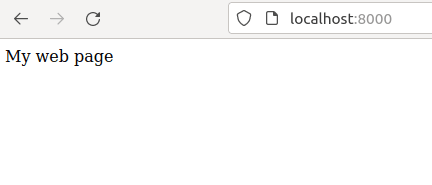No matter what kind of project you're working on, whether it be a single HTML file, or a large scale application, you always want to be able to spin up an environment where you can quickly test your work on your own machine.
Many tools these days including webpack and create-react-app come packaged with commands to spin up a local server built into them. However this tutorial is going to focus on the absolute simplest options available to getting a basic server up and running yourself to load an HTML file in your browser.
Be aware this tutorial is not about writing your own web server (we'll address that topic in a future tutorial on Node.js and Express). Right now we're only examining the fundamentals of what a web server is, and the simplest way to get an existing one up and running.
What is a Web Server?
Strictly speaking there's nothing specifically different about a "local" web server and a traditional web server. The local qualifier simply refers to be being run on the same machine you are building your site or application on.
A production web server is going to need to include a lot more features to be able to handle things like traffic volume and security; but fortunately we don't need to worry about those when serving our files locally.
All we need to worry about is getting our project to display in our browser.
A web server (specifically an HTTP server) is a piece of software designed to deliver content from one device to another.
In our case that content is an HTML file, and we are delivering it to our web browser which will display it for us.
Before we go any further it's important to outline a couple basic terms that you will encounter frequently when running a webserver:
localhost- This is an alias for the IP of your machine, typically resolving to 127.0.0.1, a loopback address that directs requests back at your own machine. You'll often refer to that IP referred to as your home address. More information here.port- The port is a special number used to refer the the process or program running on the machine that the request should be sent to. So if you were mailing a letter, you can think of the IP like a house address and the port as the person in the house the letter is addressed to. Some port numbers are reserved. For example port 80 is the default for all HTTP internet traffic. When you don't include a port number in a URL, it is assumed to be 80 by default. Making a browser request to a process on your own machine using port 8000 would look like this:http://localhost:8000
(Don't worry if you don't understand all these terms at this point, you can still run a server without knowing the finer details, but it helps to understand some of the basic concepts)
For the most part, unless you edit your operating system's hosts file, all your requests to your local server will be made to the localhost domain. The port can be assigned by you manually, or depending on what server you use, might be assigned automatically.
Some common local server ports you'll see are 3000 (used by create-react-app), 5000 (used by VS Code's Live Server extension) and port 8000 (a port developers commonly use for local servers, just by convention).
Most server applications that detect a process already running on a port on your machine will simply increment the port number by one until it finds an available port.
Running a Local Web Server
In each of these examples we assume you have a file called index.html in the root of the directory that you are running the server in.
If you don't already have one you can either use the below template, or if you are using VS Code, then you can create a file called index.html and simply press the ! key. You will get a context menu that when clicked will automatically generate a template for you:
index.html
<!DOCTYPE html>
<html>
<head>
<meta charset="UTF-8" />
</head>
<body>My web page</body>
</html>
Option 1 (Recommended): Live Server Extension (VS Code)
If you are using VS Code the easiest way is going to be installing the Live Server extension (extension id ritwickdey.liveserver).
Simply install the extension and a Go Live icon will appear on the blue bar at the lower right corner of VS Code.
After clicking it you will be able to view your web page at whatever port the server decides, the default URL being http://localhost:5500
If you have any difficulty you can refer to the full documentation here.
Edit: It has been pointed out that Live Server may present issues with SVG support. If you encounter this issue try Five Server, a fork of Live Server.
Option 2: Node Web Server
If you have Node.js installed already on your machine (you will need it for other tutorials in this series) then you will automatically have npx package runner installed as well (don't confuse npx with npm they are two different commands).
Run the following command:
npx http-server -p 8000
It will prompt you to install http-server (if it is not installed already). Afterward you can access your web page at http://localhost:8000
Option 3: Python3 Web Server
If you are on a machine with Python 3 installed, then you can run a simple webserver with the following command:
python3 -m http.server 8000
Then access your web page at http://localhost:8000
Option 4: PHP Web Server
If you already have PHP installed on your machine then you can run an easy local web server with the following command:
php -S localhost:8000
It will serve your HTML and Javascript the same as any other server, but as a nice bonus you can also include some PHP code in your index.html if you so choose (it's not necessary though).
Access your web page at http://localhost:8000
Viewing Your Web Page
Whichever option you choose, if you used the default HTML template from the previous section your result should be the same:
Wrapping Up
Now that you have the ability to view your files on a live server, you have all the tools you need to test your web app.
Though you may use more advanced tools as your stack expands, ultimately regardless of complexity you will always be able to fallback on any of these simple web servers to host the entry point of your application.
Please check out the other entries in this series! Feel free to leave a comment or question and share with others if you find any of them helpful:
- Understanding the Modern Web Stack: Running a Local Web Server
- Understanding the Modern Web Stack: Babel
- Understanding the Modern Web Stack: Webpack - The Basics
- Understanding the Modern Web Stack: Webpack - Loaders, Optimizations & Bundle Analysis
- Understanding the Modern Web Stack: Webpack - DevServer, React & Typescript
@eagleson_alex on Twitter
Thanks for reading, and stay tuned!
Thanks for reading, and stay tuned!








Top comments (2)
Live Server injects code in your source documents; most notably breaking SVG files: https://github.com/ritwickdey/vscode-live-server/search?q=svg&type=issues
Five Server, a fork of Live Server works better
marketplace.visualstudio.com/items...
Good to know, thank you!